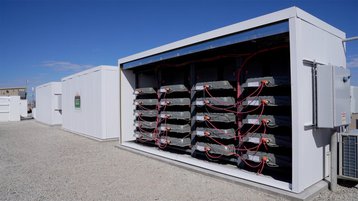Energy company B2U Storage Solutions has built 25MWh of battery storage at a solar farm in California using second-hand battery packs from electric vehicles.
The SEPV Sierra facility uses 1,300 battery packs from Honda and Nissan electric vehicles (EVs) to create 25MWh of energy storage connected to California's grid, storing renewable energy until it is needed. The facility has been in operation for three years, and recently had 4MWh of capacity added.
Electric vehicles use lithium-ion batteries which have a long lifetime but whose performance degrades making them less suitable for mobile applications. At the end of a ten-life in the vehicle, the batteries have 80 percent of their charging capacity, meaning the car will lose range, but the batteries can still do useful work in stationary applications.
With the EV market growing, there is a potentially huge future supply of second-hand car batteries on the horizon. McKinsey has estimated that the available capacity of second-life EV batteries may exceed 200 GWh by 2030.
The opportunity for use in static energy storage systems (ESS) has been known for some time. In 2015, GM announced it was testing five batteries from its since-discontinued Volt car as a power source at its Milford proving ground. Previously, Eaton demonstrated the use of second-life Nissan Leaf batteries for a UPS system.
B2U (Battery Second Use) has been running the Sierra facility commercially since 2020, expanding it in phases, and claims it raised some $1M in revenue in 2022 alone. It is now the largest storage system in the world based on second-life EV batteries. and certified to the UL 9540 safety standard.
In the facility, battery units are installed unaltered into hangers, plugged into B2U's EV pack storage (EPS) system, charged and discharged through their existing outlets, and managed by their standard battery management software. B2U says the facility could easily cope with any other EV battery, and has already tested GM Bolt and Tesla Model 3 battery packs successfully.
“B2U’s EPS technology has been developed to address the challenges of second life in large-scale energy storage. EV battery packs are deployed in cabinet enclosures utilizing the pack’s existing battery management system, virtually eliminating repurposing costs,” said Freeman Hall, co-founder and CEO of B2U Storage Solutions. “The EPS system’s Cabinet Controllers connect and disconnect batteries wired in series and parallel strings during charge and discharge cycles so that weaker batteries with lower capacity do not limit the output of stronger batteries. This approach enables our system to achieve efficient energy yield despite the variance in capacity inherent in second-life batteries.”
The safety issue is significant as large lithium battery installations have been known to catch fire when individual batteries suffer thermal runaway, and second-user systems might be expected to be less reliable. In Morris, Illinois in 2021, thousands were evacuated for four days, while firefighters struggled to contain a fire in 80 tons of second-hand EV batteries stored at Superior Battery. In August 2021, at a 300MW Tesla battery storage facility in Australia, a 13-ton shipping container caught fire and had to be allowed to burn itself out over four days.
B2U emphasizes its facility has passed UL 9540 certification and each battery is monitored, and automatically disconnected if it deviates from design limits.
Reusing batteries creates a circular economy which could also relieve the pressure to create new batteries, from the world's limited supplies of lithium.
To keep up with the demand for new lithium-ion batteries, the US Department of Energy (DOE) last year guaranteed a $2.5 billion loan to Ultium Cells, to finance the construction of new lithium-ion battery cell manufacturing facilities in Ohio, Tennessee, and Michigan. Ultium is a joint venture between General Motors and LG Energy Solution and aims to supply US demand for EV battery units.

